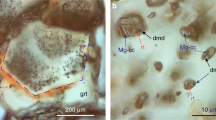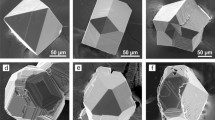Abstract
Natural diamonds were (and are) formed (thousands of million years ago) in the upper mantle of Earth in metallic melts at temperatures of 900–1,400 °C and at pressures of 5–6 GPa (refs. 1,2). Diamond is thermodynamically stable under high-pressure and high-temperature conditions as per the phase diagram of carbon3. Scientists at General Electric invented and used a high-pressure and high-temperature apparatus in 1955 to synthesize diamonds by using molten iron sulfide at about 7 GPa and 1,600 °C (refs. 4,5,6). There is an existing model that diamond can be grown using liquid metals only at both high pressure and high temperature7. Here we describe the growth of diamond crystals and polycrystalline diamond films with no seed particles using liquid metal but at 1 atm pressure and at 1,025 °C, breaking this pattern. Diamond grew in the subsurface of liquid metal composed of gallium, iron, nickel and silicon, by catalytic activation of methane and diffusion of carbon atoms into and within the subsurface regions. We found that the supersaturation of carbon in the liquid metal subsurface leads to the nucleation and growth of diamonds, with Si playing an important part in stabilizing tetravalently bonded carbon clusters that play a part in nucleation. Growth of (metastable) diamond in liquid metal at moderate temperature and 1 atm pressure opens many possibilities for further basic science studies and for the scaling of this type of growth.
This is a preview of subscription content, access via your institution
Access options
Access Nature and 54 other Nature Portfolio journals
Get Nature+, our best-value online-access subscription
$29.99 / 30 days
cancel any time
Subscribe to this journal
Receive 51 print issues and online access
$199.00 per year
only $3.90 per issue
Buy this article
- Purchase on Springer Link
- Instant access to full article PDF
Prices may be subject to local taxes which are calculated during checkout



Similar content being viewed by others
Data availability
The published data of this study are available on the Zenodo public database at https://doi.org/10.5281/zenodo.10803625 (ref. 58). Source data are provided with this paper.
References
Haggerty, S. E. Diamond genesis in a multiply-constrained model. Nature 320, 34–38 (1986).
Pal’yanov, Y. N., Sokol, A. G., Borzdov, Y. M., Khokhryakov, A. F. & Sobolev, N. V. Diamond formation from mantle carbonate fluids. Nature 400, 417–418 (1999).
Bundy, F. P. et al. The pressure-temperature phase and transformation diagram for carbon; updated through 1994. Carbon 34, 141–153 (1996).
Bundy, F. P., Hall, H. T., Strong, H. M. & Wentorfjun, R. H. Man-made diamonds. Nature 176, 51–55 (1955).
Bovenkerk, H. P., Bundy, F. P., Hall, H. T., Strong, H. M. & Wentorf, R. H. Preparation of diamond. Nature 184, 1094–1098 (1959).
Hazen, R. M. & Hazen, R. M. The Diamond Makers (Cambridge Univ. Press, 1999).
D’Haenens-Johansson, U. F. S., Butler, J. E. & Katrusha, A. N. Synthesis of diamonds and their identification. Rev. Mineral. Geochem. 88, 689–753 (2022).
Doherty, M. W. et al. The nitrogen-vacancy colour centre in diamond. Phys. Rep. 528, 1–45 (2013).
Ruf, M., Wan, N. H., Choi, H., Englund, D. & Hanson, R. Quantum networks based on color centers in diamond. J. Appl. Phys. 130, 070901 (2021).
Shikata, S. Single crystal diamond wafers for high power electronics. Diam. Relat. Mater. 65, 168–175 (2016).
Railkar, T. A. et al. A Critical Review of Chemical Vapor-Deposited (CVD) Diamond for Electronic Applications. Crit. Rev. Solid State Mater. Sci. 25, 163–277 (2000).
Butler, J. E., Mankelevich, Y. A., Cheesman, A., Ma, J. & Ashfold, M. N. R. Understanding the chemical vapor deposition of diamond: recent progress. J. Phys. Condens. Matter 21, 364201 (2009).
Yamasaki, S., Pobedinskas, P. & Nicley, S. S. Recent advances in diamond science and technology. Phys. Status Solidi A 214, 1770167 (2017).
Yarbrough, W. A. & Messier, R. J. S. Current issues and problems in the chemical vapor deposition of diamond. Science 247, 688–696 (1990).
Butler, J. E. & Windischmann, H. Developments in CVD-diamond synthesis during the past decade. MRS Bull. 23, 22–27 (1998).
Schwander, M. & Partes, K. J. D. A review of diamond synthesis by CVD processes. Diam. Relat. Mater. 20, 1287–1301 (2011).
Linde, O., Geyler, O. & Epstein, A. The Global Diamond Industry 2018: A Resilient Industry Shines Through (Bain, 2018).
Dossa, S. S. et al. Analysis of the high-pressure high-temperature (HPHT) growth of single crystal diamond. J. Cryst. Growth 609, 127150 (2023).
Ferro, S. Synthesis of diamond. J. Mater. Chem. 12, 2843–2855 (2002).
Eaton-Magaña, S., Shigley, J. E. & Breeding, C. M. Observations on HPHT-grown synthetic diamonds: a review. Gems Gemol. 53, 262–284 (2017).
Sumiya, H., Harano, K. & Tamasaku, K. HPHT synthesis and crystalline quality of large high-quality (001) and (111) diamond crystals. Diam. Relat. Mater. 58, 221–225 (2015).
Kalantar-Zadeh, K. et al. Emergence of liquid metals in nanotechnology. ACS Nano 13, 7388–7395 (2019).
Taccardi, N. et al. Gallium-rich Pd–Ga phases as supported liquid metal catalysts. Nat. Chem. 9, 862–867 (2017).
Daeneke, T. et al. Liquid metals: fundamentals and applications in chemistry. Chem. Soc. Rev. 47, 4073–4111 (2018).
Camacho-Mojica, D. C. et al. Charge transfer during the dissociation of H2 and the charge state of H atoms in liquid gallium. J. Phys. Chem. C 123, 26769–26776 (2019).
Ueki, R. et al. In-situ observation of surface graphitization of gallium droplet and concentration of carbon in liquid gallium. Jpn. J. Appl. Phys. 51, 06FD28 (2012).
Fujita, J.-I. et al. Near room temperature chemical vapor deposition of graphene with diluted methane and molten gallium catalyst. Sci. Rep. 7, 12371 (2017).
Upham, D. C. et al. Catalytic molten metals for the direct conversion of methane to hydrogen and separable carbon. Science 358, 917–921 (2017).
Allioux, F.-M. et al. Carbonization of low thermal stability polymers at the interface of liquid metals. Carbon 171, 938–945 (2021).
Kawasaki, H. et al. A liquid metal catalyst for the conversion of ethanol into graphitic carbon layers under an ultrasonic cavitation field. Chem. Commun. 58, 7741–7744 (2022).
Zuraiqi, K. et al. Direct conversion of CO2 to solid carbon by Ga-based liquid metals. Energy Environ. Sci. 15, 595–600 (2022).
Li, P. C. Preparation of single-crystal graphite from melts. Nature 192, 864–865 (1961).
Tulloch, H. J. C. & Young, D. A. Synthetic single crystals of graphite. Nature 211, 730–731 (1966).
Sumiyoshi, Y., Ushio, M. & Suzuki, S. Formation of graphite single crystal from iron solution by the slow cooling method. Bull. Chem. Soc. Jpn. 61, 1577–1585 (1988).
Noda, T., Sumiyoshi, Y. & Ito, N. Growth of single crystals of graphite from a carbon-iron melt. Carbon 6, 813–816 (1968).
Austerman, S. B., Myron, S. M. & Wagner, J. W. Growth and characterization of graphite single crystals. Carbon 5, 549–557 (1967).
Merel, P., Tabbal, M., Chaker, M., Moisa, S. & Margot, J. Direct evaluation of the sp3 content in diamond-like-carbon films by XPS. Appl. Surf. Sci. 136, 105–110 (1998).
Chu, C., d’Evelyn, M., Hauge, R. & Margrave, J. Mechanism of diamond growth by chemical vapor deposition on diamond (100), (111), and (110) surfaces: carbon-13 studies. J. Appl. Phys. 70, 1695–1705 (1991).
Cai, W. et al. Synthesis and solid-state NMR structural characterization of 13C-labeled graphite oxide. Science 321, 1815–1817 (2008).
Yang, B. et al. Fabrication of silicon-vacancy color centers in diamond films: tetramethylsilane as a new dopant source. CrystEngComm 20, 1158–1167 (2018).
Feng, Z., Lin, Y., Tian, C., Hu, H. & Su, D. Combined study of the ground and excited states in the transformation of nanodiamonds into carbon onions by electron energy-loss spectroscopy. Sci. Rep. 9, 3784 (2019).
Luo, K. et al. Coherent interfaces govern direct transformation from graphite to diamond. Nature 607, 486–491 (2022).
Tulić, S. et al. Covalent diamond–graphite bonding: mechanism of catalytic transformation. ACS Nano 13, 4621–4630 (2019).
Wi, T.-G., Park, Y.-J., Lee, U. & Kang, Y.-B. Methane pyrolysis rate measurement using electromagnetic levitation techniques for turquoise hydrogen production: liquid In, Ga, Bi, Sn, and Cu as catalysts. Chem. Eng. J. 460, 141558 (2023).
Gong, Y. et al. Homoepitaxial diamond grown in a liquid metal solvent. ChemRxiv. Preprint at https://doi.org/10.26434/chemrxiv-2022-q8ppf (2022).
Ohtsuka, Y. et al. Theoretical study on the C–H activation of methane by liquid metal indium: catalytic activity of small indium clusters. J. Phys. Chem. A 123, 8907–8912 (2019).
Kresse, G. & Furthmüller, J. Efficient iterative schemes for ab initio total-energy calculations using a plane-wave basis set. Phys. Rev. B 54, 11169–11186 (1996).
Perdew, J. P., Burke, K. & Ernzerhof, M. Perdew, Burke, and Ernzerhof reply. Phys. Rev. Lett. 80, 891 (1998).
Perdew, J. P., Burke, K. & Ernzerhof, M. Generalized gradient approximation made simple. Phys. Rev. Lett. 77, 3865–3868 (1996).
Grimme, S., Antony, J., Ehrlich, S. & Krieg, H. A consistent and accurate ab initio parametrization of density functional dispersion correction (DFT-D) for the 94 elements H-Pu. J. Chem. Phys. 132, 154104 (2010).
Nosé, S. A unified formulation of the constant temperature molecular dynamics methods. J. Chem. Phys. 81, 511–519 (1984).
Nose, S. Constant-temperature molecular dynamics. J. Phys. Condens. Matter 2, SA115 (1990).
Hoover, W. G. Canonical dynamics: equilibrium phase-space distributions. Phys. Rev. A 31, 1695–1697 (1985).
Frenkel, D. & Smit, B. Understanding Molecular Simulation: From Algorithms to Applications (Academic Press, 1996).
Sharma, B. D. & Donohue, J. A refinement of the crystal structure of gallium. Z. Kristallogr. Cryst. Mater. 117, 293–300 (1962).
Assael, M. J. et al. Reference data for the density and viscosity of liquid cadmium, cobalt, gallium, indium, mercury, silicon, thallium, and zinc. J. Phys. Chem. Ref. Data 41, 033101 (2012).
Cohen, J. Statistical Power Analysis for the Behavioral Sciences (Academic Press, 2013).
Yan, G., Da, L. & Rodney, R. Source data for “Growth of diamond in liquid metal at 1 atmosphere pressure”. Zenodo https://doi.org/10.5281/zenodo.10803625 (2024).
Acknowledgements
This work was supported by the Institute for Basic Science (IBS-R019-D1). We thank S. Y. Lee for preliminary XRD measurements at the 9C beamline of Pohang Accelerator Laboratory to evaluate the crystalline property of the diamond sample, and B. Cunning for suggesting the EDM-3 Poco Graphite sheet material and for discussions. The experiments at the PLS-II 6D and 9 C beamline were supported in part by MSIT, POSTECH and UNIST Central Research Facilities. We thank K.-S. Lee of the UNIST Center Research Facilities for making the TOF-SIMS measurements. The DFT calculations were conducted on the IBS supercomputer.
Author information
Authors and Affiliations
Contributions
R.S.R. supervised the project. R.S.R., D.L. and Y.G. conceived the experiments. Y.G. did the growth experiments. Y.G. and D.L. characterized the diamond samples. W.K.S. designed, assembled and built, and tested the cold-wall system and the thermocouple probe array. M.C. and Z.L. took the TEM, STEM, EELS and EDS measurements. P.B. took the XPS measurements. T.J.S. and S.L. took the XRD measurements. Y.K., B.R., M.Z., I.K.P. and G.L. performed the theoretical calculations. M.W. contributed through discussion. Y.G. wrote a draft manuscript and R.S.R., D.L. and Y.G. revised it. All co-authors commented on the manuscript before its submission.
Corresponding authors
Ethics declarations
Competing interests
The Institute for Basic Science has filed a patent application (KR 10-2023-0052752) that lists Y.G., D.L. and R.S.R. as inventors. Other than this, the authors declare no competing interests.
Peer review
Peer review information
Nature thanks Anirudha Sumant and the other, anonymous, reviewer(s) for their contribution to the peer review of this work. Peer reviewer reports are available.
Additional information
Publisher’s note Springer Nature remains neutral with regard to jurisdictional claims in published maps and institutional affiliations.
Source data
Rights and permissions
Springer Nature or its licensor (e.g. a society or other partner) holds exclusive rights to this article under a publishing agreement with the author(s) or other rightsholder(s); author self-archiving of the accepted manuscript version of this article is solely governed by the terms of such publishing agreement and applicable law.
About this article
Cite this article
Gong, Y., Luo, D., Choe, M. et al. Growth of diamond in liquid metal at 1 atm pressure. Nature (2024). https://doi.org/10.1038/s41586-024-07339-7
Received:
Accepted:
Published:
DOI: https://doi.org/10.1038/s41586-024-07339-7
Comments
By submitting a comment you agree to abide by our Terms and Community Guidelines. If you find something abusive or that does not comply with our terms or guidelines please flag it as inappropriate.



